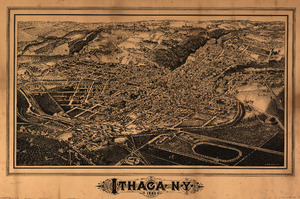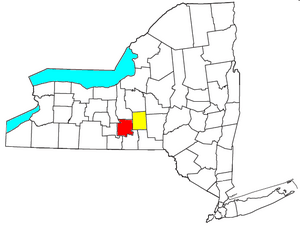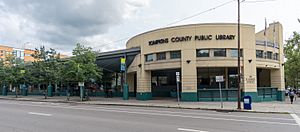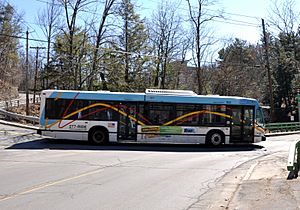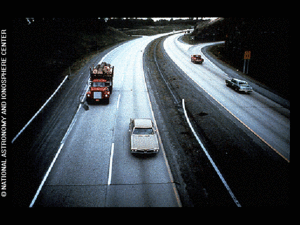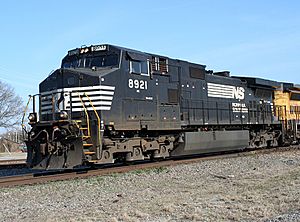Ithaca, New York facts for kids
Quick facts for kids
Ithaca, New York
|
||
|---|---|---|
|
Clockwise from top left: Ithaca Commons, Ithaca Falls, Cornell University, Herbert F. Johnson Museum of Art
|
||
|
||
| Country | United States | |
| State | New York | |
| County | Tompkins | |
| Founded | 1790 | |
| Incorporated | 1888 | |
| Named for | Ithaca, Greece | |
| Government | ||
| • Type | Council–manager | |
| • Body | Common Council | |
| Area | ||
| • City | 6.07 sq mi (15.72 km2) | |
| • Land | 5.39 sq mi (13.96 km2) | |
| • Water | 0.68 sq mi (1.77 km2) | |
| • Urban | 24.581 sq mi (63.66 km2) | |
| • Metro | 474.649 sq mi (1,229.34 km2) | |
| Elevation | 404 ft (123 m) | |
| Population
(2020)
|
||
| • City | 32,108 | |
| • Density | 5,958.06/sq mi (2,300.47/km2) | |
| • Urban | 53,661 | |
| • Urban density | 2,183.03/sq mi (842.872/km2) | |
| • Metro | 105,740 | |
| • Metro density | 222.775/sq mi (86.014/km2) | |
| Demonym(s) | Ithacan | |
| Time zone | UTC−5 (EST) | |
| • Summer (DST) | UTC−4 (EDT) | |
| ZIP Codes |
14850, 14851, 14852, and 14853
|
|
| Area code(s) | 607 | |
| FIPS code | 36-38077 | |
| GNIS feature IDs | 970238, 979099 | |
Ithaca (/ˈɪθəkə/) is a city in New York, United States. It is the main city of Tompkins County. Ithaca is located on the southern shore of Cayuga Lake. This lake is part of the beautiful Finger Lakes region.
The city is named after the Greek island of Ithaca. In 2020, about 32,108 people lived here. Ithaca is known as a college town. It is home to Cornell University, a famous Ivy League school. Ithaca College is also located here. Nearby, you can find Tompkins Cortland Community College (TC3).
Contents
History of Ithaca
Early Days and Native Americans

For thousands of years, Native Americans lived in this area. When Europeans arrived, the Cayuga tribe controlled this land. They were one of the five tribes of the Iroquois Confederacy. Jesuit missionaries came from New France in 1657. They hoped to convert the Cayuga people.
Later, other tribes like the Saponi and Tutelo settled near Cayuga Lake. They had been forced from their homes in Virginia and North Carolina. During the American Revolutionary War, some Iroquois nations helped the British. In response, the 1779 Sullivan Expedition destroyed many Native American villages. This forced many Iroquois people to leave the state.
Founding and Early Growth
In 1788, explorers from Kingston, New York, came to the area. The next year, some families built log cabins. In 1790, the U.S. government began giving land in this area to soldiers. This land was called the Central New York Military Tract.
Simeon De Witt, a surveyor, helped map this land. He later moved to Ithaca. The area was known by names like "The Flats" or "Sodom." De Witt renamed it Ithaca, after the Greek island. He chose this name because many towns in the region were named after places in classical literature.
Around 1791, De Witt divided the downtown area into lots and sold them. The first grist mill was built on Cascadilla Creek. By 1805, the village had a post office and a tavern.
19th Century Developments
Ithaca became important for shipping salt and gypsum. In 1810, the Owego Turnpike was built. This road helped connect Ithaca to other trade routes. The first steamboat on Cayuga Lake, the Enterprise, launched in 1820. In 1821, Ithaca became an official village.
The Ithaca and Owego Railroad started in 1834. It connected the Erie Canal to the Susquehanna River. This helped expand trade. Later, more railroads were built to connect Ithaca to other cities. These were mainly funded by Ezra Cornell.
In 1883, the Ithaca Gun Company was founded. They made shotguns. The factory used power from a nearby waterfall. Famous people like John Philip Sousa and Annie Oakley used their guns. The company's shotguns were used by police departments for many years.
Ithaca became a city in 1888. The Ithaca Children's Home was established in 1885. The first trolley system started in 1887.
Ithaca claims to be the birthplace of the ice cream sundae in 1892. A shop owner put cherry syrup and a cherry on vanilla ice cream for a priest. The priest suggested naming it after Sunday. Also in 1892, the Ithaca Kitty became one of the first mass-produced stuffed toys in the U.S.
20th Century and Beyond
In the early 1900s, Ithaca was important for the silent film industry. The Wharton Studio made many films here, often using the local scenery. However, film production moved to Hollywood later.
In 1903, a health challenge affected the city. This led to improvements in the city's sanitation system. After World War II, General Electric's Langmuir Research Labs became a major employer.
Ithaca is known for its political activism. Martin Luther King Jr. spoke in Ithaca in the early 1960s. The annual Ithaca Festival often promotes social and cultural themes.
In the 21st century, there have been efforts to clean up old industrial sites. The former Ithaca Gun building site was cleaned up due to lead in the soil. It is now planned for new apartments.
In 2011, Svante Myrick was elected mayor. He was the youngest mayor of Ithaca.
Geography and Climate
Natural Beauty of Ithaca
Ithaca is located at the southern end of Cayuga Lake. The area has many deep gorges, rapids, and waterfalls. These were formed by ancient ice sheets. Famous examples include Fall and Cascadilla Creeks in Ithaca. Nearby are Buttermilk Falls and Taughannock Falls.
The land around Ithaca is mostly made of shale and sandstone. You can find interesting rocks left by glaciers here. The city was first built on flat land. This land formed from silt filling the lake's southern end. Later, the city grew onto the surrounding hills. These include East Hill, West Hill, and South Hill.
The area's natural forests have many deciduous trees. These include maple, sycamore, and oak. There are also coniferous trees like white pine. Ithaca has over 190 different tree species. This helps keep the city beautiful and healthy.
Weather in Ithaca
| Weather chart for Ithaca | |||||||||||||||||||||||||||||||||||||||||||||||
|---|---|---|---|---|---|---|---|---|---|---|---|---|---|---|---|---|---|---|---|---|---|---|---|---|---|---|---|---|---|---|---|---|---|---|---|---|---|---|---|---|---|---|---|---|---|---|---|
| J | F | M | A | M | J | J | A | S | O | N | D | ||||||||||||||||||||||||||||||||||||
|
2
32
16
|
1.9
33
15
|
2.6
42
24
|
2.9
55
35
|
3.3
67
45
|
3.6
76
54
|
3.6
81
58
|
3.5
79
57
|
3.4
72
50
|
3.1
60
40
|
2.7
47
32
|
2.4
35
21
|
||||||||||||||||||||||||||||||||||||
| temperatures in °F precipitation totals in inches |
|||||||||||||||||||||||||||||||||||||||||||||||
|
Metric conversion
|
|||||||||||||||||||||||||||||||||||||||||||||||
Ithaca has a warm-summer humid continental climate. This means summers are warm but short. The rest of the year is cool to cold. Winters are long and snowy. About 67 inches (170 cm) of snow falls each year.
Winter usually has freezing temperatures and cloudy skies. There can be light or heavy snowfalls. Sometimes, very cold air brings temperatures below 0°F (-18°C). Summers are sunny with moderate heat and humidity. Afternoon thunderstorms are common.
The growing season for plants is about 141 days long. The first snow usually falls in November, and the last in April. The lowest temperature ever recorded was -25°F (-32°C). The highest was 103°F (39°C).
Local residents sometimes call mixed rain, wind, and snow "ithacation." This is common in late fall and early spring. The Finger Lakes region is good for winemaking. This is because the lakes create special local weather conditions.
| Climate data for Ithaca, New York (Cornell University), 1991–2020 normals and extremes 1893–present | |||||||||||||
|---|---|---|---|---|---|---|---|---|---|---|---|---|---|
| Month | Jan | Feb | Mar | Apr | May | Jun | Jul | Aug | Sep | Oct | Nov | Dec | Year |
| Record high °F (°C) | 70 (21) |
73 (23) |
85 (29) |
91 (33) |
96 (36) |
102 (39) |
103 (39) |
101 (38) |
100 (38) |
91 (33) |
81 (27) |
69 (21) |
103 (39) |
| Mean maximum °F (°C) | 55.6 (13.1) |
54.6 (12.6) |
64.4 (18.0) |
79.2 (26.2) |
85.5 (29.7) |
89.6 (32.0) |
90.5 (32.5) |
89.3 (31.8) |
87.3 (30.7) |
78.1 (25.6) |
68.6 (20.3) |
57.1 (13.9) |
92.6 (33.7) |
| Mean daily maximum °F (°C) | 31.0 (−0.6) |
33.1 (0.6) |
40.8 (4.9) |
54.5 (12.5) |
67.3 (19.6) |
75.7 (24.3) |
79.9 (26.6) |
78.5 (25.8) |
71.6 (22.0) |
59.0 (15.0) |
46.8 (8.2) |
36.2 (2.3) |
56.2 (13.4) |
| Daily mean °F (°C) | 22.8 (−5.1) |
24.1 (−4.4) |
31.3 (−0.4) |
43.7 (6.5) |
55.6 (13.1) |
64.6 (18.1) |
68.9 (20.5) |
67.4 (19.7) |
60.2 (15.7) |
49.0 (9.4) |
38.6 (3.7) |
29.1 (−1.6) |
46.3 (7.9) |
| Mean daily minimum °F (°C) | 14.6 (−9.7) |
15.1 (−9.4) |
21.8 (−5.7) |
32.9 (0.5) |
44.0 (6.7) |
53.4 (11.9) |
57.9 (14.4) |
56.3 (13.5) |
48.8 (9.3) |
38.9 (3.8) |
30.4 (−0.9) |
22.0 (−5.6) |
36.3 (2.4) |
| Mean minimum °F (°C) | −8.0 (−22.2) |
−5.3 (−20.7) |
1.8 (−16.8) |
19.3 (−7.1) |
29.0 (−1.7) |
38.7 (3.7) |
45.9 (7.7) |
43.8 (6.6) |
34.0 (1.1) |
25.9 (−3.4) |
15.5 (−9.2) |
3.4 (−15.9) |
−10.9 (−23.8) |
| Record low °F (°C) | −25 (−32) |
−25 (−32) |
−17 (−27) |
−1 (−18) |
22 (−6) |
31 (−1) |
38 (3) |
32 (0) |
24 (−4) |
15 (−9) |
−5 (−21) |
−22 (−30) |
−25 (−32) |
| Average precipitation inches (mm) | 2.24 (57) |
1.98 (50) |
2.78 (71) |
3.40 (86) |
3.20 (81) |
3.98 (101) |
3.90 (99) |
3.77 (96) |
3.83 (97) |
3.70 (94) |
2.94 (75) |
2.57 (65) |
38.29 (973) |
| Average snowfall inches (cm) | 16.6 (42) |
14.5 (37) |
12.0 (30) |
2.8 (7.1) |
0.0 (0.0) |
0.0 (0.0) |
0.0 (0.0) |
0.0 (0.0) |
0.0 (0.0) |
0.2 (0.51) |
4.6 (12) |
12.2 (31) |
62.9 (160) |
| Average precipitation days (≥ 0.01 in) | 16.1 | 13.1 | 14.0 | 13.6 | 14.6 | 13.8 | 12.7 | 11.7 | 11.5 | 15.2 | 14.1 | 15.7 | 166.1 |
| Average snowy days (≥ 0.1 in) | 12.3 | 9.6 | 7.1 | 1.7 | 0.0 | 0.0 | 0.0 | 0.0 | 0.0 | 0.1 | 3.4 | 9.1 | 43.3 |
| Source: NOAA | |||||||||||||
People of Ithaca
| Historical population | |||
|---|---|---|---|
| Census | Pop. | %± | |
| 1870 | 8,462 | — | |
| 1880 | 9,105 | 7.6% | |
| 1890 | 11,079 | 21.7% | |
| 1900 | 13,136 | 18.6% | |
| 1910 | 14,802 | 12.7% | |
| 1920 | 17,004 | 14.9% | |
| 1930 | 20,708 | 21.8% | |
| 1940 | 19,730 | −4.7% | |
| 1950 | 29,257 | 48.3% | |
| 1960 | 28,732 | −1.8% | |
| 1970 | 26,226 | −8.7% | |
| 1980 | 28,799 | 9.8% | |
| 1990 | 29,541 | 2.6% | |
| 2000 | 29,287 | −0.9% | |
| 2010 | 30,014 | 2.5% | |
| 2020 | 32,108 | 7.0% | |
| U.S. Decennial Census | |||
Ithaca is the main city of the Ithaca-Cortland area. This area includes Tompkins County and Cortland County. In 2000, about 145,100 people lived in this combined area.
In 2000, the city of Ithaca had 29,287 people. There were 10,287 households. About 14.2% of households had children under 18. The average age in the city was 22 years old. Many people in Ithaca are students.
Greater Ithaca Area
"Greater Ithaca" includes the City and Town of Ithaca. It also includes smaller places nearby.
Some specific areas are also part of Greater Ithaca:
Education in Ithaca
Colleges and Universities
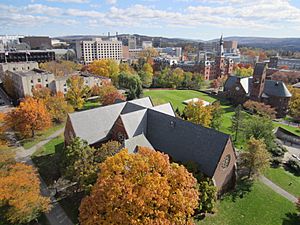
Ithaca is a big center for education. Two main colleges are here. Ezra Cornell founded Cornell University in 1865. It is on East Hill, overlooking the city. Women could attend Cornell starting in 1870. Ezra Cornell also started a public library for the city.
Ithaca College began in 1892 as a music school. It moved to South Hill in the 1960s. In 2018, Cornell had 23,600 students. Ithaca College had 6,700 students. Tompkins Cortland Community College is in nearby Dryden. It also has a center in downtown Ithaca.
Public Schools
The Ithaca City School District serves the city and nearby areas. It has about 5,500 students from kindergarten to 12th grade. There are eight elementary schools and two middle schools. Ithaca High School is also part of the district. The Lehman Alternative Community School is a combined middle and high school.
Several private schools are in the Ithaca area. These include Immaculate Conception School and the Cascadilla School. There are also Montessori and Waldorf schools. Ithaca supports families who choose to homeschool their children.
Public Library
The Tompkins County Public Library is located downtown. It serves all of Tompkins County. It is the main library for the Finger Lakes Library System. The library has almost 260,000 items. It lends out about 800,000 items each year.
Economy of Ithaca
Ithaca's economy relies on education, farming, technology, and tourism. In 2006, Ithaca's economy was growing. Many people from nearby counties come to Ithaca for work.
Ithaca has kept its traditional downtown shopping area. This includes the Ithaca Commons, a pedestrian mall. Collegetown is another business area near Cornell University. It has restaurants, shops, and apartments. Students from Cornell often visit Collegetown.
Ithaca has many businesses typical of college towns. These include bookstores and unique restaurants. The Moosewood Restaurant, founded in 1973, is famous for its vegetarian cookbooks. Ithaca offers many local and ethnic food options.
The Ithaca Farmers Market started in 1973. It is located at Steamboat Landing. This is where steamboats used to dock on Cayuga Lake.
Agriculture and Research
Ithaca has strong ties to farming and dairy. This is because Cornell University has a College of Agriculture and Life Sciences. About 60 small farms are in the Ithaca area. Cornell also has research farms. Their Dairy Research Facility supports New York's milk and yogurt industries.
Media in Ithaca
The Ithaca Journal is a daily newspaper. It was founded in 1815. The Ithaca Voice is a non-profit online news site. The Ithaca Times is a free weekly newspaper. The Cornell Daily Sun is also published here.
Ithaca has several radio stations:
- WICB 91.7 FM (student-run)
- WPIE 1160 AM/107.1 FM "ESPN Ithaca" (sports)
- WQNY "Q-Country" 103.7 FM (country music)
- WINO 88.1 FM (community radio)
- WVBR-FM 93.5 FM/105.5 FM (student-owned, music and sports)
- WYXL "Lite Rock" 97.3 FM
- WHCU 870 AM (news/talk)
- WNYY 1470 AM (progressive talk)
- WIII 99.9 FM (classic rock)
Public radio stations include:
- WSQG 90.9 FM (WSKG-FM's Ithaca frequency)
- WITH 90.1 FM (translator for WRUR-FM)
Culture and Attractions

The Sciencenter opened in 1983. It is a hands-on science museum for all ages. The Museum of the Earth opened in 2003. It is a natural history museum that shows the Earth's 4.5-billion-year history. It has interactive displays.
The Cayuga Nature Center teaches about the environment. It used to be a facility for children with tuberculosis. The Cornell Lab of Ornithology studies birds. Visitors can see displays and learn about bird sounds.
The Herbert F. Johnson Museum of Art at Cornell has a great art collection. It includes art from Asia, Africa, Europe, and the Americas.
Ithaca has several professional theaters. The Hangar Theatre opened in 1975 in an old airport hangar. It hosts plays in the summer. The Kitchen Theatre Company started in 1991. The Cherry Arts opened in 2017.
Ithaca is known for its annual community events. The Ithaca Festival is a big celebration. Ithaca also hosts one of the largest used-book sales in the U.S.
The Constance Saltonstall Foundation for the Arts supports artists and writers. The Namgyal Monastery in Ithaca is the North American home of the 14th Dalai Lama's monastery.
Other festivals include The Apple Festival in the fall and the Chili Fest in February. There is also the Finger Lakes International Dragon Boat Festival and the Ithaca Brew Fest. Porchfest is held in September.
Ithaca has unique local programs. The Ithaca Health Fund is a cooperative health insurance. Ithaca Hours is one of the first local currency systems in the United States.
Music Scene
Ithaca is home to the Cayuga Chamber Orchestra. The Cornell Concert Series has hosted musicians since 1903. It features classical music, world music, and jazz.
The Ithaca College School of Music was founded in 1892. It offers degrees in music performance and education. The Ithaca Talent Education school teaches music to children using the Suzuki Method. The Community School of Music and Art offers classes to students of all ages.
Many musicians live in Ithaca. These include Samite of Uganda and The Horse Flies. John Brown's Body and X Ambassadors are also from here. Folk music is popular, with a long-running live concert broadcast called Bound for Glory.
The Finger Lakes GrassRoots Festival of Music and Dance is held every July. It features over 60 local and international music acts. Ithaca has a lively live music scene. There are over 80 places to hear live music nearby.
Transportation in Ithaca
In 2009, Ithaca had the highest percentage of people who walked to work in the U.S. (15.1%). In 2013, it had the second-lowest percentage of people who drove alone (68.7%).
Roads and Car Sharing
Ithaca is about 225 miles (362 km) northwest of New York City. Larger cities like Binghamton and Syracuse are about an hour away by car. Rochester and Scranton are two hours away.
Ithaca is not directly on an interstate highway. All car trips involve driving on two-lane state highways. These include Routes 13, 34, and 79.
In 2008, Ithaca Carshare began. It is a service where members can share cars. This has become popular for city residents and college students.
Bus Services
Ithaca has frequent intercity bus service. Companies like Greyhound Lines and New York Trailways offer trips. You can travel to Binghamton and New York City. Cornell University also runs a bus between its Ithaca campus and its medical school in Manhattan.
Tompkins Consolidated Area Transit (TCAT) provides public transportation for Tompkins County. TCAT operates 34 bus routes. Many run seven days a week. They offer frequent service to downtown, Cornell University, and Ithaca College.
GADABOUT Transportation Services helps older residents and people with disabilities. Ithaca Dispatch provides taxi service.
Airports
Ithaca is served by Ithaca Tompkins International Airport. It is about three miles northeast of the city center. In 2019, the airport completed a big renovation. It now has a larger terminal and a customs facility for international flights.
Delta Connection offers flights to John F. Kennedy International Airport. United Express offers daily flights to Newark Liberty International Airport.
Railways
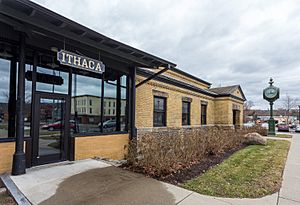

Passenger trains used to serve Ithaca until 1961. You could travel to New York City, Philadelphia, and Buffalo. The trip from New York City took about seven hours.
Within Ithaca, electric streetcars ran from 1887 until 1935. Ithaca was one of the first cities in New York with a street railway.
Today, the main rail traffic is salt from the Cargill salt mine. The Norfolk Southern Railway operates a line that runs along Fulton Street in Ithaca.
Places to Visit in Ithaca
- Buttermilk Falls State Park
- Carl Sagan's Grave
- Cayuga Nature Center
- Cornell Botanic Gardens
- Cornell University
- Finger Lakes Trail
- Ithaca College
- Ithaca Commons
- Ithaca Dog Park
- Ithaca Falls
- Paleontological Research Institution's Museum of the Earth
- Robert H. Treman State Park
- Sagan Planet Walk
- Sapsucker Woods Sanctuary
- Sciencenter
- Stewart Park
- Taughannock Falls State Park
Images for kids
-
The falls at Buttermilk Falls State Park
Famous People from Ithaca
Reputation of Ithaca
Ithaca is known for its liberal politics. It is often called one of the most culturally open small cities in America. In 1997, Utne Reader called Ithaca "America's most enlightened town."
In its early days, Ithaca was sometimes called "Sodom." This was because it had a reputation for horse racing, gambling, and other activities. But Simeon De Witt renamed it Ithaca. Today, Ithaca is known for its growing wineries, local breweries, live music, colleges, and small farms.
See also
 In Spanish: Ithaca (Nueva York) para niños
In Spanish: Ithaca (Nueva York) para niños









